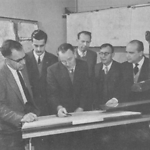Corporate Body
International Antarctic Analysis Centre (IAAC) (1959 - 1965)
- From
- 2 February 1959
Melbourne, Victoria, Australia - To
- 1965
- Functions
- Meteorology and Industrial or scientific research
- Location
- Melbourne, Victoria
Summary
The International Antarctic Analysis Centre (IAAC) was established in Melbourne in 1959 as an international enterprise, staffed by meteorologists from a number of countries, at the invitation of the Special Committee on Antarctic Research (SCAR). Its aims were: to develop scientific analytical techniques; to produce regular synoptic analyses for the surface and the upper air for the Antarctic and adjacent regions; to make these analyses available for operational purposes and research in related sciences; and, to investigate problems of Antarctic meteorology. It achieved substantial improvements in the quality and operational viability of circumpolar southern hemisphere analysis. The IAAC was led by H.R. Phillpot, Commonwealth Bureau of Meteorology.
Related entries
Timeline
1959 - 1965 International Antarctic Analysis Centre (IAAC)
1964 - ? Southern Hemisphere Analysis Centre
1965 - 1969 International Antarctic Meteorological Research Centre
National Meteorological Analysis Centre
1985 - 1990s National Meteorological Centre
Published resources
Resources
- Trove, National Library of Australia, 2009, https://nla.gov.au/nla.party-1476158. Details
See also
- Federation and Meteorology, 2001, http://www.austehc.unimelb.edu.au/fam/index_i.html. Details
Digital resources
A. Smith & H. Morgan
Created: 19 February 2001, Last modified: 16 March 2006
- Foundation Supporter - National Council for the Centenary of Federation

